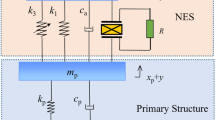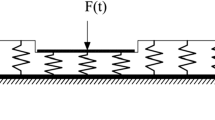Abstract
Background
Viscoelasticity is a property of materials that present elastic and viscous behavior when they experience deformation. The simplest model that can represent the viscoelastic behavior is generally called the Standard Linear Solid model or Zener model.
Purpose
Based on the Zener model, the objective of this paper is to present the concept and the design of equivalent electromechanical systems that permit the emulation of viscoelastic behavior. Besides, the possibility of harvesting the energy normally wasted as heat in viscoelastic materials is also considered.
Methods
The methods applied in this paper are based on the analytic development of equations in time and frequency domain, including optimization and numerical simulations.
Results
Equivalent equations were derived considering the mechanical and electromechanical analogy. These equations were verified by correlating known results from the literature. New results for white noise excitation were obtained and optimization of power harvesting was performed.
Conclusions
The proposed electromechanical system is equivalent to the Zener system if its mechanical damping is small when compared to the equivalent electrical damping effect. Resulting in viscoelastic behavior without the need of viscoelastic materials, electromechanical equivalent Zener systems also allow energy recovery whilst maintaining vibration isolation.









Similar content being viewed by others
References
Antoniou A, Naidu K (1973) Modeling of a gyrator circuit. IEEE Trans Circuit Theory 20(5):533–540. https://doi.org/10.1109/tct.1973.1083731
Brennan MJ, Carrella A, Waters TP, Lopes V Jr (2008) On the dynamic behaviour of a mass supported by a parallel combination of a spring and an elastically connected damper. J Sound Vib 309(3–5):823–837. https://doi.org/10.1016/j.jsv.2007.07.074
Christensen R (2012) Theory of viscoelasticity: an introduction. Elsevier, New York
Deboo GJ (1970) Gyrator type circuit. US Patent 3,493,901
Den Hartog JP (1985) Mechanical vibrations. Courier Corporation, Chelmsford
Derby TF, Calcaterra PC (1970) Response and optimization of an isolation system with relaxation type damping. Shock Vib Bull 40(5):203–216
Franca LF (2011) A bit-rock interaction model for rotary-percussive drilling. Int J Rock Mech Min Sci 48(5):827–835. https://doi.org/10.1016/j.ijrmms.2011.05.007
de Haro Silva L, Gonçalves PJP, Wagg D (2018) On the dynamic behavior of the zener model with nonlinear stiffness for harmonic vibration isolation. Mech Syst Signal Process 112:343–358. https://doi.org/10.1016/j.ymssp.2018.04.037
Huang X, Sun J, Hua H, Zhiyi Z (2018) Design scheme of a passive isotropic multi-strut vibration isolation platform constructed by three-parameter isolators based on the optimum damping frequency concept. J Vib Control 24(17):3931–3943. https://doi.org/10.1177/1077546317717403
Irving RS (2003) Integers, polynomials, and rings: a course in algebra. Springer Science & Business Media, Berlin
James HM, Nichols NB, Phillips RS (1947) Theory of servomechanisms, vol 25. McGraw-Hill, New York
Kaul S, Karimi S, Shabanisamghabady M (2017) Vibration isolators with stiffness nonlinearity using maxwell–voigt models. In: Constitutive models for rubber X. Proceedings of the European Conference on Constitutive Models for Rubbers X, pp. 495–501. CRC Press. Munich, Germany. https://doi.org/10.1201/9781315223278-77
Kuhnert WM, Cammarano A, Silveira M, Gonçalves PJP (2019) Power available on a nonlinear electromechanical system. In: Balthazar JM, Tusset AM, Ribeiro MA, Lenz WB (eds) Booklet of abstracts - XV vibration engineering and technology of machinery. VETOMAC 2019, pp. 90-91. Vibration Institute of India. Curitiba, Brazil.
Kuhnert WM, Cammarano A, Silveira M, Gonçalves PJP (2020) Optimum design of electromechanical vibration isolators. J Vib Control. https://doi.org/10.1177/1077546320925362
Kuhnert WM, Silveira M, Gonçalves PJP (2019) Parameter Optimization and Active Control of Electromechanical Suspension Systems. In: Fleury A, Rade D, Kurka P (eds) Proceedings of DINAME 2017. DINAME 2017. Lecture Notes in Mechanical Engineering, pp. 265-276. Springer, Cham. São Sebastião, Brazil. https://doi.org/10.1007/978-3-319-91217-2_18
Lee DO, Park G, Han JH (2014) Development of vibration isolation platform for low amplitude vibration. In: Active and passive smart structures and integrated systems 2014, vol 9057. International Society for Optics and Photonics, pp 905708. https://doi.org/10.1117/12.2044984
Lee DO, Park G, Han JH (2015) Experimental study on on-orbit and launch environment vibration isolation performance of a vibration isolator using bellows and viscous fluid. Aerosp Sci Technol 45:1–9. https://doi.org/10.1016/j.ast.2015.04.012
Lee DO, Park G, Han JH (2016) Hybrid isolation of micro vibrations induced by reaction wheels. J Sound Vib 363:1–17. https://doi.org/10.1016/j.jsv.2015.10.023
Maria G, Selvaganesan N, Kumar BA, Kapoor S (2015) Dynamic analysis and sliding mode vibration control for a two storeyed flexible building structure. In: 2015 international conference on control communication & computing India (ICCC). IEEE, pp. 24–29. Trivandrum, India. https://doi.org/10.1109/iccc.2015.7432864
Merrill JL Jr (1951) Theory of the negative impedance converter. Bell Syst Tech J 30(1):88–109. https://doi.org/10.1002/j.1538-7305.1951.tb01368.x
Muller P (2005) Are the eigensolutions of a 1-dof system with viscoelastic damping oscillatory or not? J Sound Vib 285(1–2):501–509
Muravyov A, Hutton SG (1998) Free vibration response characteristics of a simple elasto-hereditary system. J Vib Acoust 120:628–632
Newland DE (2012) An introduction to random vibrations, spectral and wavelet analysis. Courier Corporation, Chelmsford
Ondřej M, Michal K, Zbyněk S, Jakub R, Petr N, Ivan M (2018) Axial and pressure thrust stiffness of metal bellows for vibration isolators. In: Tandom P, Wisnoe W, bin Abdullah MZ. The 4th International Conference of Mechatronics and Mechanical Engineering (ICMME 2017). MATEC Web of Conferences, vol 153, p 06001. EDP Sciences. Lumpur, Malaysia. https://doi.org/10.1051/matecconf/201815306001
Park G, Lee DO, Han JH (2016) Design of three parameter isolator for the RWA disturbance considering flexible structural effects. In: 57th AIAA/ASCE/AHS/ASC structures, structural dynamics, and materials conference. p 1478. ARC AIAA. San Diego, USA. https://doi.org/10.2514/6.2016-1478
Preumont A (2006) Mechatronics. Springer, Berlin
Roylance D (2001) Engineering viscoelasticity, vol 2139. Department of Materials Science and Engineering, Massachusetts Institute of Technology, Cambridge, pp 1–37
Ruzicka JE, Derby TF (1971) Influence of damping in vibration isolation. Shock and Vibration Information Center, San Diego
Shi W, Qian C, Chen Z, Cao Y, Zhang H (2016) Modeling and dynamic properties of a four-parameter zener model vibration isolator. Shock Vib. https://doi.org/10.1155/2016/5081812
Stephen NG (2006) On energy harvesting from ambient vibration. J Sound Vib 293(1–2):409–425. https://doi.org/10.1016/j.jsv.2005.10.003
Sun L, Chen L (2017) Residual mode correction in calibrating nonlinear damper for vibration control of flexible structures. J Sound Vib 406:197–207. https://doi.org/10.1016/j.jsv.2017.06.015
Tanner RI (2000) Engineering rheology, vol 52. Oxford University Press, Oxford
Wang X, Yao H, Zheng G (2017) Enhancing the isolation performance by a nonlinear secondary spring in the zener model. Nonlinear Dyn 87(4):2483–2495. https://doi.org/10.1007/s11071-016-3205-3
Yamakawa I (1961) On the free vibration and the transient state of one-degree-of-freedom system with elastically supported viscous damper. Bull JSME 4(16):641–644
Acknowledgements
The first author was supported by Grant #2016/17083-4 and Grant #2018/02150-3, São Paulo Research Foundation (FAPESP).
Author information
Authors and Affiliations
Corresponding author
Ethics declarations
Conflict of interest
The authors declare that they have no conflict of interest.
Additional information
Publisher's Note
Springer Nature remains neutral with regard to jurisdictional claims in published maps and institutional affiliations.
Grants #2016/17083-4 and #2018/02150-3, São Paulo Research Foundation (FAPESP).
Rights and permissions
About this article
Cite this article
Kuhnert, W.M., Cammarano, A., Silveira, M. et al. Synthesis of Viscoelastic Behavior Through Electromechanical Coupling. J. Vib. Eng. Technol. 9, 367–379 (2021). https://doi.org/10.1007/s42417-020-00235-0
Received:
Revised:
Accepted:
Published:
Issue Date:
DOI: https://doi.org/10.1007/s42417-020-00235-0




